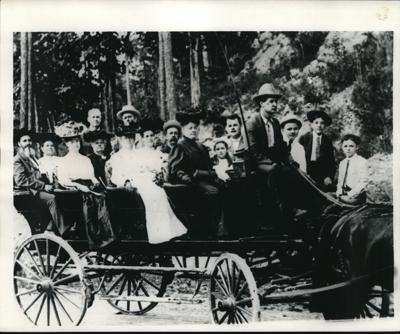For years, people came from all corners of the country for a chance to soak in the healing waters of central Louisiana.
You heard right — not central Arkansas, but central Louisiana, where northwest of Turkey Creek stood a resort once nicknamed the Sarasota Springs of Louisiana.
No one talks about it anymore. Most don't even know it existed.
But Shreveport resident Mary D'Anna knows, because her mom still talks about it.
"There was a resort in northern Evangeline Parish that reported to have curative powers," she said. "People would come to bathe in the spring waters. It was named after a beautiful young woman from the stories I have heard. My mother, who is still living, tells of family picnics and bathing in the waters. Can you find any information about this resort?"
The place was called Belle Cheney Springs Resort.
Louisiana writer Cheré Dastugue Coen states in her thorough account of the resort, "Taking the Waters: Belle Cheney — the southern Saratoga," found online at 64parishes.org/taking-the-waters for the Louisiana Endowment for the Humanities' 64 Parishes magazine, "First called Dog Springs, the springs were later named for a Miss Cheney of Evangeline Parish or Cheneyville, according to conflicting newspaper accounts, one from as early as 1843."
Stories told by members of the "If You Grew Up in Ville Platte ..." Facebook group page describe Miss Belle Cheney as a beautiful woman from nearby Cheneyville, who died in 1890.
Bobby Dardeau, whose Ville Platte publication Bonnes Nouvelles includes stories of the area, added that people would travel from as far as New York to partake of the healing waters.
"I've never written about Belle Cheney Resort, but the Ville Platte Gazette did a front page story on it," he said. "There are stories about people coming from all over. They used to ride in a stage coach or carriage from New Orleans and Baton Rouge to the resort."
He's right. At least one photo survives in The Advocate-The Times Picayune archives showing visitors of the late 1800s-early 1900s piled into a wagon transport to Belle Cheney Springs.

An item in the Jan. 11, 1853, edition of The Times-Picayune announces the purchase of Belle Cheney Springs by J.J. Beauchamp and Joseph Daigle Jr., who turned the area into a resort.
But that was then. Now, Dardeau said, anyone wanting to find these natural springs would need a guide to help them negotiate the terrain.
"It's overgrown with vines," he said. "It would be hard to find without someone to show you where it is."
Coen's description of today's Belle Cheney landscape is more detailed: "Tree farms and gravel pits now dot the landscape where the miraculous waters once flowed in the piney woods northwest of Turkey Creek."
"The cold springs about four miles from Cocodrie Lake and thirty-eight miles north of Opelousas were discovered in the early nineteenth century by sportsmen who bathed their dogs in the waters bubbling from the ground," Coen continues. "The hunters noticed the dog’s skin diseases disappearing and told others of the spring’s healing properties, wrote Velma Juneau in 'Belle Cheney Springs' for the Federal Writers’ Project of the Works Progress Administration in 1936."

An article from the Aug. 18, 1937, edition of the State-Times, which once was The Advocate's sister afternoon paper, discusses John W. Lewis' attempt to revive Belle Cheney Springs Resort.
Which is how it came to be known as Dog Springs in the beginning. But word quickly spread, and the dogs were crowded out by people who hoped the waters would cure their ailments.
The Times-Picayune documented Belle Cheney Springs' opening in 1851, with three springs supplying the water.
"J. Beauchamp and Joseph Daigle Jr. purchased the property in January 1853," Coen writes. "They advertised to the public a resort that included accommodations, bathing areas with spring water, live music, and balls twice a week, as well as opportunities for hunting and fishing from May 1 to November 1. The cost was one dollar per day or twenty-five dollars per month with discounts given for children and servants."
Visitors often traveled to the resort by way of the Texas and Pacific or Morgan Railroad to LeCompte Station, then rode the rest of the way on horses supplied by a local livery. Dirt roads later accommodated travel by horse and buggy.
Coen writes that the resort "was considered an evacuation site for those wishing to flee Union-occupied areas such as New Orleans" during the Civil War, and as transportation became more sophisticated in the late 1800s, the resort expanded to include summer houses, a swimming pool, an electric plant to power the resort, and springs harnessed by concrete.
The centerpiece, though, was the Belle Cheney Hotel, which was always packed with tourists.
But that was the resort's heyday. Coen writes that it fell on hard times after the turn of the 20th century.
"Crowell & Spencer Lumber Company and Opelousas lawyer John W. Lewis purchased the springs in the hope of initiating its renewal," she writes. "'For years they were all but forgotten and its buildings have entirely disappeared,' the Eunice News reported of Belle Cheney in 1937. 'Some years ago a swimming pool was built in a glen entering the property and today a few visitors occasionally find their way to the springs.'"
Coen continues, writing that the springs are reported to have dried up.
"All that remains of the resort are concrete foundations located on private property," she writes, "On Google Maps, the location is still called Belle Cheney Springs, situated off a remote rural road near the Glenmora Turkey Creek Highway."




